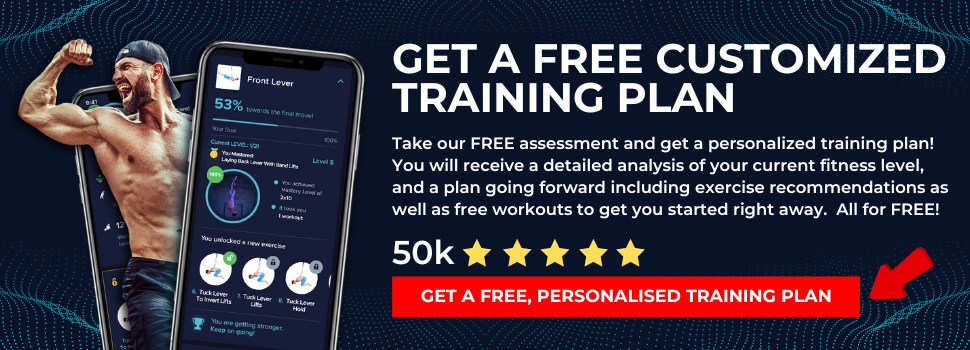Welcome to the calisthenics workout routine for upper body.
Hey, how’s it going? So, you’re diving into the world of beginner calisthenics workouts and looking for the best calisthenics training plan for the upper body? Awesome choice!
Before we dive into that, I’ve got some golden nuggets of wisdom to drop on you.
Let’s kick things off by talking about a classic rookie mistake many folks make when selecting a workout routine. They stumble upon some random PDF or online program and just leap right in, without even considering if it’s the right fit. Sound familiar? Trust me, after coaching a ton of athletes, my team and I have seen this scenario unfold countless times.
Imagine this: someone attempting pull-ups without laying the groundwork, or feeling stuck because their workouts are as easy as pie. Frustrating, right?
Now, if you’re following some cookie-cutter training plan, you’re bound to hit a snag or two. First off, what if you can’t nail some of the exercises? You might push through and end up hurting yourself. And then there’s the flip side – what if the plan is just a walk in the park for you? You’re not gonna see much progress that way.
So, here’s the scoop: one-size-fits-all routines don’t always hit the mark. Sure, they might seem convenient, but they often miss the personalization aspect crucial for progress. That’s where we step in.
We used to slap workouts with beginner, intermediate, and advanced labels. But let me tell you, that approach held back a bunch of our athletes’ progress. We’ve even dived into this topic in detail in one of our blog posts, “The End of Beginner/Intermediate/Advanced – How personalization is the key to calisthenics training that will make you invincible.”
The bottom line? Lack of personalization can seriously stall your progress.
Imagine tackling exercises way beyond your skill level – that’s a recipe for disaster. And if they’re too easy, you’re just spinning your wheels. That’s why we created The Movement Athlete Academy – to dish out personalized training plans tailored to your level for max results.
And guess what? You can snag a FREE assessment to snag a customized plan just for you. No more fretting over injuries or puzzling out which exercises are your jam. Trust me, it’s a game-changer. So, let’s smash those fitness goals together!
you can also read more about how we create the most effective calisthenics workouts for your specific level, what are the elements of a successful calisthenics workout, how do progressions work and more here.
How to Build Upper Body Strength with Calisthenics
A lot of people think that they need to go to the gym and do a bunch of bench presses, bicep curls, and shoulder shrugs to get stronger.
However, most of these exercises isolate one muscle group at a time and neglect other groups like your back and core muscles. This is why calisthenics is such an effective way to build upper body strength because you use multiple muscle groups at once with bodyweight exercises!
In this blog post, we’ll talk about how to make the most out of your calisthenics upper body workout. No need for gym memberships, all you need is just your bodyweight and some easy-to-find equipment!
If you are looking for a great upper body workout that will unleash the Man of Steel in you then, you are in the right place.
The Steel Upper Body workout is created for those who want and need strength training and muscle building at the same time using bodyweight training.
Calisthenics is famous for displaying superhuman strength skills and tricks. So this workout will give you good foundational strength for those who want to get upper body skills down, such as straight bar muscles ups, planches, and levers.
Take note that you still need to train the skill and progression specifically if you really want to learn the move. This workout will supplement your quest for the skill and of course, make you like a greek god in the process.
Upper body calisthenics workout
Just a reminder that his workout focuses on upper body exercises using the best calisthenics exercises to reach your strength and muscle development.
If you like you’re looking for full-body training, then you can add a separate leg day or two within your training schedule.
Prepare yourself because you’ll be dealing with high volume to get strength and muscle gains going. Minimum rest periods between exercises are implemented to push your muscles near muscle failure to get your strength to move mountains.
I forgot to emphasize that the whole workout takes only about 30 minutes. Oh my! Think about the time you can save while still gaining an upper body made out of steel.
NOT FOR BEGINNERS
The workout is on an intermediate level so don’t get discouraged if you can’t pull off the exercises and the routine yet. You’ll get there in time. Beginners should first learn the fundamental exercises using the right progressions suitable for their skill level.
As I say in all posts, it is sometimes good to be a beginner. Back in the days when I was starting there wasn’t whole a lot on this topic but now when there are tons of instructional videos and tutorials you can really easily learn the right form of every exercise and progress from there. If you ask me, a proper form of execution was my biggest problem back in the day. That’s why very often I give huge attention to this point.
Remember the basics
Even if the workout is for more experienced athletes, we’re still going to use basic movements because BASIC DOESN’T MEAN EASY.
With the right structuring of compound exercises using the best bodyweight exercises, you can build muscle, lose weight and develop strength.
So here’s a basic saying that we will go over and over again with bodyweight training (or even in weight training or any other disciplines in the fitness industry):
Quality over Quantity! Form is everything!
Never forget the basic golden rules when performing every exercise.
These rules are are essential to get the best from your workout routine. Keep them in mind and heart. No amount of expertise can make you leave out these basic rules.
Also, be sure to get good blood flow and joint movement with a proper warm-up before starting this calisthenics workout.
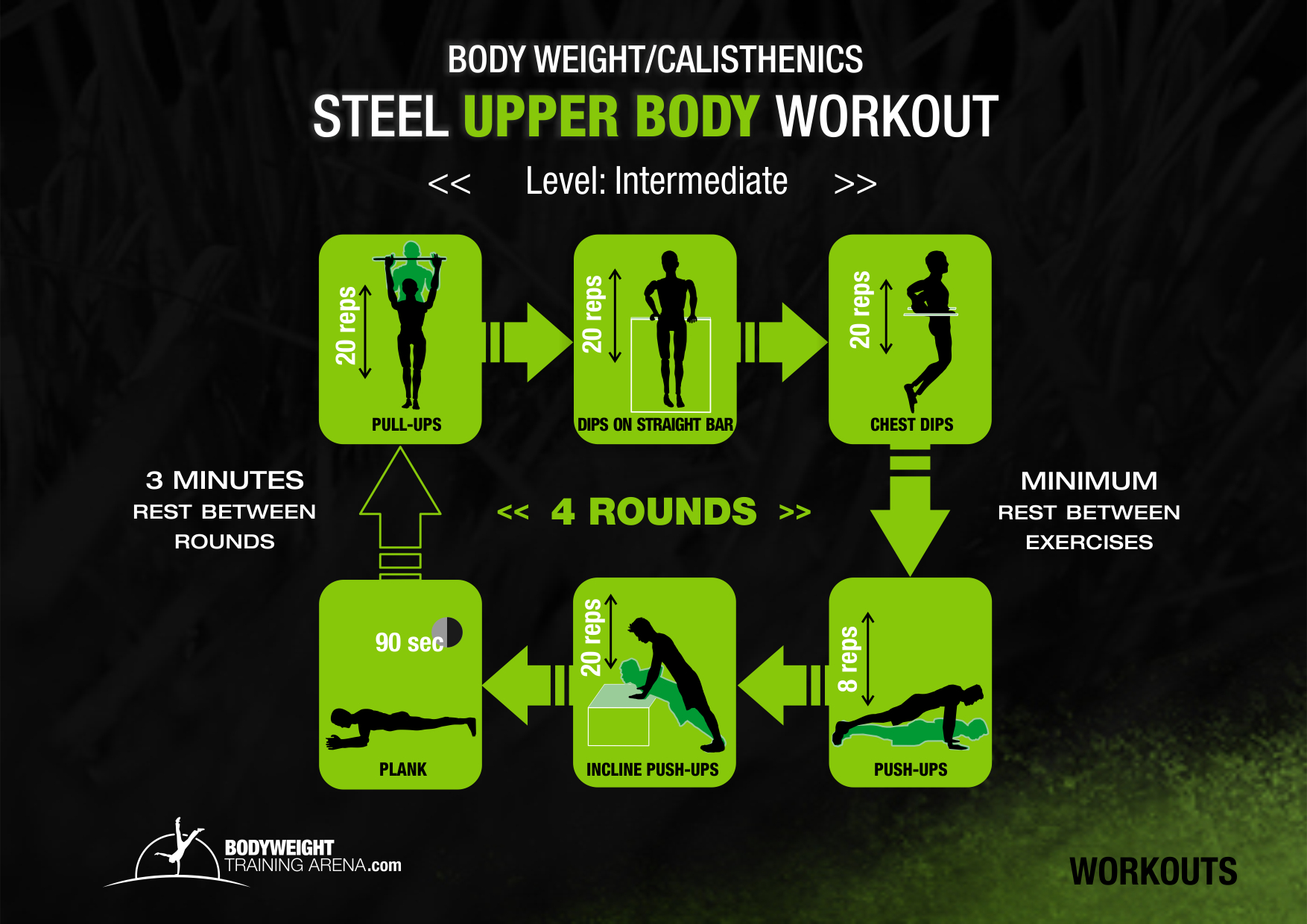
| Move | Sets | Reps |
| Pull-ups | 1 | 20 |
| Dips on Straight Bar | 1 | 20 |
| Chest Dips | 1 | 20 |
| Push-ups | 1 | 8 |
| Incline Push ups | 1 | 20 |
| Plank | 1 | 90s |
Rest for a minimum amount between each exercise and rest for 3 minutes for each round. Total of 4 rounds.
How far in the game are you?
Our certified coaches have developed a fail-proof assessment to give you an idea of where you stand in the Calisthenics game.
STEEL UPPER BODY WORKOUT
Level
Time
Goal
Intermediate
30 minutes
Strength Building
How it’s done
Pull-ups
Your back and bicep builder ,basic yet still very effective, is a staple of an upper-body regimen. From your dead hang, depress your scapulas to transition into a active hang. This motion will active your lats even more.
From the active hang, drive your elbows towards your hips. Try to nearly touch the bar with your chest. You’ll get a slight arch in your back which is not a mortal sin against your form. Actually, it is the better form for more lats activation. You could still do the pull-ups with a straight body line but this will engage your core more than your lats.
You can also play with pull ups variations to achieve more specific goals. For example, you can use chin ups to target more of your biceps. You can also use explosive pull ups to prepare yourself for muscle ups.
You can also harder variations for more advanced athletes such as the L-sit pull-ups with legs straight in the L-sit position.
Neutral pull ups are also perfect if you’re experiencing any pain in your elbow region when doing chin ups.
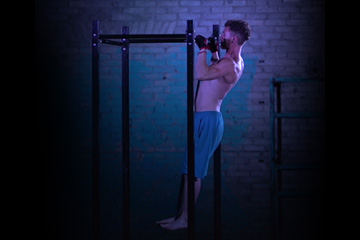
How to perform:
- Dead hang on a pull up bar with hands shoulder-width apart.
- Depress and retract your scapula to move to an active hang.
- Pull up towards the bar until your chin is over the bar.
- Lower down with control.
- Repeat for reps.
Coaching Pointers:
- Maintain an active hang during the motions and only release back dead hang at the bottom
- Full range of motion
- Drive elbows towards your hips as a cue
- Core engaged
- Full body tension
Dips on Straight Bar
If you want to master the muscle up, you’ve got to train this exercise. Dips on a straight bar focus on the chest with tricep and shoulder activation on the side. Lean forward a bit to get to the 90 degree angle on the arms and lean your lower body forward also to get the balance down.
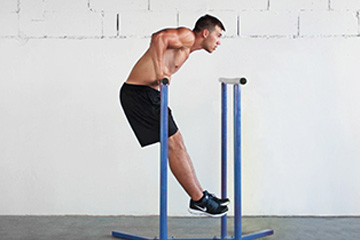
How to perform:
- Begin in a straight arm support hold on a straight bar.
- Slowly lower down until your chest touches the bar.
- Push back up to the starting position.
- Repeat for reps.
Coaching Pointers:
- Maintain scapula depression
- Don’t let elbows flare out
- Core engage
- Full body tension
Chest Dips
The next exercise will still focus on your chest, triceps, and shoulders. The difference is the amount of load you’ll put on your chest. You’ll be on parallel bars so the bar will not hinder you to go lower compared to the earlier dip variation. Aim to get lower than 90 degrees that your shoulders (flexibility and strength-wise) can handle so bear more load on your chest. Do the chest dip by tilting forward and looking down.
You can also increase the difficulty of the exercise by adding weights or moving onto gymnastics rings.
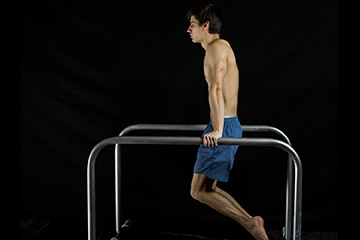
How to perform:
- Begin in a support hold position on parallel bars or dip bars with arms straight and hands shoulder width.
- Bend your arms by lowering slowly your entire body. Lower until mobility and strength permits: ideally at least 90-degree arms or lower.
- Push back up to the starting position.
- Repeat for reps.
Coaching Pointers:
- Maintain scapula depression
- Don’t let elbows flare out
- Core engage
- Full body tension
- Maintain a forward lean to activate more of your chest muscles.
Push-ups
Push-ups are a staple calisthenics exercises. Do your good old regular push-ups for even more chest, tricep, and shoulder activation.
Push ups have tons of variations and can achieve different goals and focus. With this, you can also play with variations similar to the pull ups.
For example:
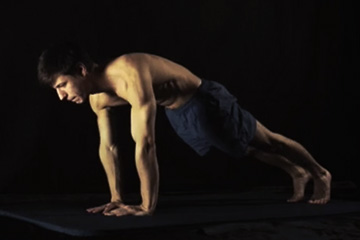
How to perform:
- Begin a push-up position with arms straight, legs extended, straight bodyline.
- Lower your body until your chest nearly touches the round
- Push back up to starting position.
- Repeat for reps.
Coaching Pointers:
- Maintain scapula depression
- Scapula protraction at the top; retraction at the bottom
- Don’t let elbows flare out
- Core engage
- Full body tension
- Lean forward when going down
Incline Push-ups
You’re probably tired but let’s push the chest, triceps, and shoulders for the last time with an easier push-up variation.
Find a comfortable height you can execute with: the higher the elevation, the easier the exercise and vise-versa. Same key points as the regular push-ups. It’s quite similar to wall push-ups. We’re going to do this to increase the training volume for our pushing muscles.
Again, you can play around with this specific exercise. You can also do the harder push-up variation from the last exercise before moving to this one to focus on specific muscle groups.
For example:
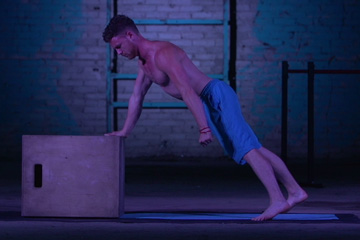
How to perform:
- Begin a push-up position with hands on an elevated surface with arms straight, legs extended, straight bodyline.
- Lower your body until your chest nearly touches the round
- Push back up to starting position.
- Repeat for reps.
Coaching Pointers:
- Maintain scapula depression
- Scapula protraction at the top; retraction at the bottom
- Don’t let elbows flare out
- Core engage
- Full body tension
- Lean forward when going down
Plank
Finish the routine with a core isometric exercise which is one of the best calisthenics exercises, the plank.
The position is quite similar to the starting position of push-ups but you’re on your elbows this time with shorter leverage which adds core demands. Although considered as a core exercise, it also trains other muscle groups like the shoulders and the glutes which stabilizes you into position.
Training planks will provide excellent core strength transfer to other calisthenics exercises as well.
Protract your scapula. Keep a straight body line and contract all muscles. Please, I can’t stress this enough: breath normally. This will push your body even harder.
You can also switch to hollow body hold or one-arm plank if ever you can easily get to 1 minute mark easily.

How to perform:
- Place your elbows on the floor, shoulder width.
- Extend your legs backward.
- Keep a straight body line.
- Hold for a specified amount of time.
Coaching Pointers:
- Maintain scapula depression
- Scapula protraction
- Core engage
- Full body tension
- Straight bodyline
- Tilt your pelvis backward
But what if I can’t do some of these exercises?
Then we need to adjust your training, But before that let me tell you something:
WHY USING A COOKIE-CUTTER TRAINING ROUTINES (like the one above) WILL HINDER YOUR PROGRESS AND WHAT TO DO ABOUT IT
Create an optimal training routine just for you
This is a problem a lot of us run into. We’re given routines – usually based on a standardized level – beginner, intermediate, advanced. Calisthenics Academy used to do that too – because it’s very hard to create personalized training for each and every person unless we spend a significant amount of time with them.
There was just one problem with this approach (actually there are a lot of problems with it) – it hindered our athletes’ progress. We’ve written extensively on the matter in the blog post, The end of beginner/intermediate/advanced – that is hurting your training.
Lack of personalisation is hurting your training.
Imagine if some of these exercises above were too hard for you. Your body will try to compensate with poor form, movement dysfunction,, and possibly risk injury if it’s too challenging.
If some of these exercises were too easy they wouldn’t challenge your muscles to grow – you’d simply be wasting your time.
This is why we created The Movement Athlete: to offer a fully personalized training program reflecting exactly where your level is for optimal performance. Get your own program that’s perfect only for you.
Take the assessment to see how do you stack up on 8 fundamental calisthenics moves
Stay strong, friends!
References:
Nóbrega, S. R., & Libardi, C. A. (2016). Is Resistance Training to Muscular Failure Necessary? Frontiers in Physiology, 7, 10. http://doi.org/10.3389/fphys.2016.00010
Morton, R. W., Oikawa, S. Y., Wavell, C. G., Mazara, N., McGlory, C., Quadrilatero, J., . . . Phillips, S. M. (2016, May 12). Neither load nor systemic hormones determine resistance training-mediated hypertrophy or strength gains in resistance-trained young men.J Appl Physiol (1985). 2016 Jul 1;121(1):129-38. 10.1152/japplphysiol.00154.2016

